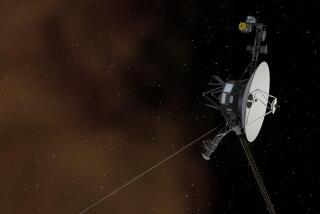Voyager May Be Heading for a Bumpy Ride
- Share via
MOJAVE — The Voyager used tail winds generated by a tropical storm southeast of Guam to nudge itself along Monday on its historic attempt to fly nonstop around the world. But the craft’s weatherman warned that the pilots had already passed the best weather they are likely to see for some time.
Thus, Dick Rutan, 49, and Jeana Yeager, 34, face some serious turbulence as they fly their fragile-looking, but surprisingly tough, airplane across the South China Sea today and then on to the northern Indian Ocean.
Len Snellman, meteorologist for the Voyager, said the weather so far has been “exceptionally favorable” for this time of the year. Although there were a few storms in the southwestern Pacific, Snellman said ground controllers at Voyager headquarters here had been able to “thread (the Voyager) through relatively inactive areas.”
The plane stayed below 7,000 feet most of Sunday and Monday to take advantage of tail winds as it inched along at about 123 miles an hour.
The Voyager and its crew could come in for some rough traveling in the next few days because of stormy weather, especially over the Indian Ocean.
That is a matter of considerable concern because the spindly aircraft bounces around the sky even under the best of circumstances, and strong turbulence could prove to be the pilots’ most formidable adversary.
Once before, while flying the Voyager across country to attend an air show in Oshkosh, Wis., Rutan and Yeager had to land because high winds made the flight so tiring. The cockpit of the plane is so cramped and noisy that it is difficult for the pilots to sleep, and turbulence would make that problem far worse.
Will Fly on One Engine
The Voyager used both its fore and aft piston-powered engines to fly across the Pacific, but sometime Monday night, after enough fuel had been burned to lighten the aircraft, the forward engine was to be shut down. From that point on, the more efficient rear engine is to do the job by itself, although the forward engine could be restarted in an emergency.
The Voyager took off from Edwards Air Force Base near here at 8 a.m. Sunday for what is expected to be a 10-day trip around the world. Rutan, a retired Air Force fighter pilot who flew 325 combat missions in Vietnam, stayed at the controls until 5:45 a.m. Monday.
At that time, he went through a contortionist’s nightmare, which he will have to repeat every time he changes places with Yeager. When it is time for Yeager to take the controls, Rutan explained in an earlier interview, he has to hang his lanky frame over the narrow bunk while she slides under him and into the pilot’s seat, which is the only seat aboard the plane.
Designed by Brother
The Voyager was created by Rutan’s brother, Burt, a highly respected innovator in aircraft design. According to the two brothers, they were sitting in a restaurant several years ago, discussing the possibility of building an airplane that could fly nonstop around the world. Burt, the story goes, picked up a napkin and made the first sketch of what became the Voyager.
Although some pilots who watched the takeoff wondered why the design did not include skids on the wing tips, the fact that the flight continued after the wing tips were ripped off shows that the Voyager belongs to a new generation of airplanes. And aeronautical engineers around the world are watching the flight because of what it may tell them about Space Age materials.
The weight of the aircraft is a scant 939 pounds, although it lifted off Sunday with nearly five tons of fuel. That performance was possible because the plane is built out of a plastic-type material called Hercules Magnamite, manufactured by Hercules Aerospace Co., one of the Voyager’s corporate sponsors.
The graphite fiber material is stronger than steel and lighter than aluminum. Weight is critical because each pound of structural weight requires six pounds of fuel for the 27,000-mile flight.
Great Flexibility
The material is so flexible that the wing tips of the Voyager can lift and fall as much as 28 feet, making the plane look like a bird in flight.
That flexibility allowed the wings to droop so far with the heavy fuel load that the tips hit the runway, but the strength of the material held damage to a minimum.
“We couldn’t have done it if it had been a metal plane” because damage would have been far greater, Voyager spokesman Peter Riva said after the takeoff.
As the Voyager passed south of the Hawaiian Islands at 4:45 a.m. Monday, a chase plane from Hilo flew alongside for a while to inspect the plane, which was damaged slightly during the takeoff when the wing tips scraped along the runway.
“They . . . found her to be sound,” Riva said.
The exact course of the Voyager will depend on weather. Tentative plans call for it to skirt the southern coast of India later this week, pass over Africa and on across the Atlantic early next week and land at Edwards on Christmas Eve.
More to Read
Sign up for Essential California
The most important California stories and recommendations in your inbox every morning.
You may occasionally receive promotional content from the Los Angeles Times.










